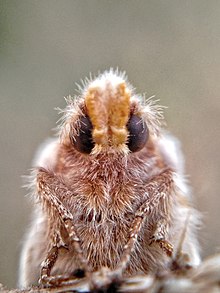Euthrix potatoria
| Drinker | |
|---|---|

| |
| Scientific classification | |
| Kingdom: | |
| Phylum: | |
| Class: | |
| Order: | |
| Family: | |
| Genus: | |
| Species: | E. potatoria
|
| Binomial name | |
| Euthrix potatoria | |
| Synonyms | |
| |
Euthrix potatoria, the drinker, is an orange-brown moth of the family Lasiocampidae. It is found in Europe.
The moth's wingspan is 45–65 mm and is identifiable by two white spots on the forewings. It flies from June to August depending on the location.
The larvae feed on various grasses and reeds. The species' common and scientific names derive from the larva's supposed drinking of drops of dew.[1]
Description
Larvae and pupae


The species gets its English (and Latin) name from the habits of the caterpillar which is supposed to have a liking for drops of dew. The fully grown larva is about 6 cm long, hairy, striped and spotted, with distinctive tufts fore and aft. Larvae hibernate while young and resume feeding in the spring, pupating in a cocoon during the summer.[2]
Imago

The imago has a wingspan of 45–65 mm. The yellowish females are slightly larger than the orange-brown male but both sexes usually show the two distinctive white spots on the forewing.
Habitat
The drinker moth is most frequently found in marshy places, fens and riversides but may also be seen in drier, grassy terrain. It is a nocturnal flier, seen in July and August. Males especially are attracted to light.[2]
Food
Grasses and reeds form the bulk of the food plants for larvae.
Status
The species is fairly common in the southern half of Britain. In a recent survey to determine the status of all macro moths in Britain this species was classified as common.
The VC55 Status is fairly common in Leicestershire and Rutland, but possibly declining. L&R Moth Group status is common and resident.
References
External links
